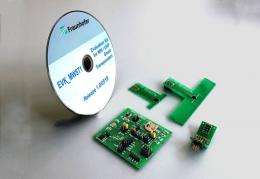Two for one: Radio chip and sensor combine to measure weather

RFID technology is on the advance. But, up to now radio chips primarily supply data for the identification of products. Researchers have now developed a transponder which measures temperature, pressure and humidity. The chip with sensor function could revolutionize the applications market.
"Special storage instructions: The serum has to be stored at between +2° Celsius and +8° Celsius. Freezing as well as storage at a higher temperature has to be avoided as the efficacy and tolerability could be affected." Instructions of this kind are found on many package inserts. Drugs, vaccines or banked blood are very sensitive to temperature. Therefore, doctors, pharmacists and hospitals have a refrigerator for this purpose. But, what happens during transport between the pharmaceutical supplier and the ultimate customer? In order to monitor temperatures during transport, manufacturers can rely on a new RFID technology in future: If the temperature rises unexpectedly during refrigerated transport, the intelligent chip notices the variation immediately and reports the fact to the reader.
This extended RFID technology is a development of the Fraunhofer Institute for Photonic Microsystems IMPS located in Dresden. The researchers have fitted the small radio labels with a sensor. Now this new type of transponder transmits not only data, such as batch or identification numbers. They have integrated sensors which measure certain parameters: irrespective of whether it is temperature, pressure or humidity - the requested ambient parameter is permanently controlled in this way. "
We have combined the UHF (Ultra-High Frequency) transponder technology with sensor technology," says project manager Hans-Jürgen Holland.
The UHF transponders transmit signals in a frequency range between 860 Megahertz and 2.45 Gigahertz, and have a larger transmission range than conventional RFID transponders. But, joining a transponder with a sensor module has been a challenge to researchers so far: "The maximum energy which can be transmitted to a UHF transponder is very low," explains Hans-Jürgen Holland.
Passive tags are radio chips which draw the energy for signal transmission from the energy field of the reader - that is from the unit which receives and reads all data. Thus, passive transponders do not need a current source of their own, but however they can operate only in the range of the reader. As a rule this is between two and six metres in UHF transponders.
"Given this tight energy balance, it has not been possible up to now to integrate sensory functions in addition," explains Hans-Jürgen Holland. "After all, the sensors need current as well. But now we have managed," says the researcher.
A micro-controller on the module ensures that the data measured by the sensor are compressed and partially processed. In this way the data volume which the transponder transmits to the reader is decreased - the energy consumption decreases as well. In addition, the reader can transmit the command to control the sensors. Thus, they are not in continuous operation. Now the researchers have developed a basic element which can be adapted to the requested applications of the customer. This module contains specifically manufactured chips suitable for series production which permit the transponder module and the sensor module to be coupled.
Researchers anticipate many areas of application for the UHF transponder technology, primarily in the medical field - they call it Lifetronics: apart from conventional batch documentation, the tags could be used to monitor the cold chain of blood products or vaccines. But, plasters could also be provided with the transponders. Moisture and temperature provide information on the progress of wound healing. During the Electronica Fair organized in Munich from 9th to 12th November, the experts will present an evaluation kit which consists of a motherboard, two antennas for UHF and MW range and the software. Thus, users can develop their individual solutions.
Provided by Fraunhofer-Gesellschaft


















